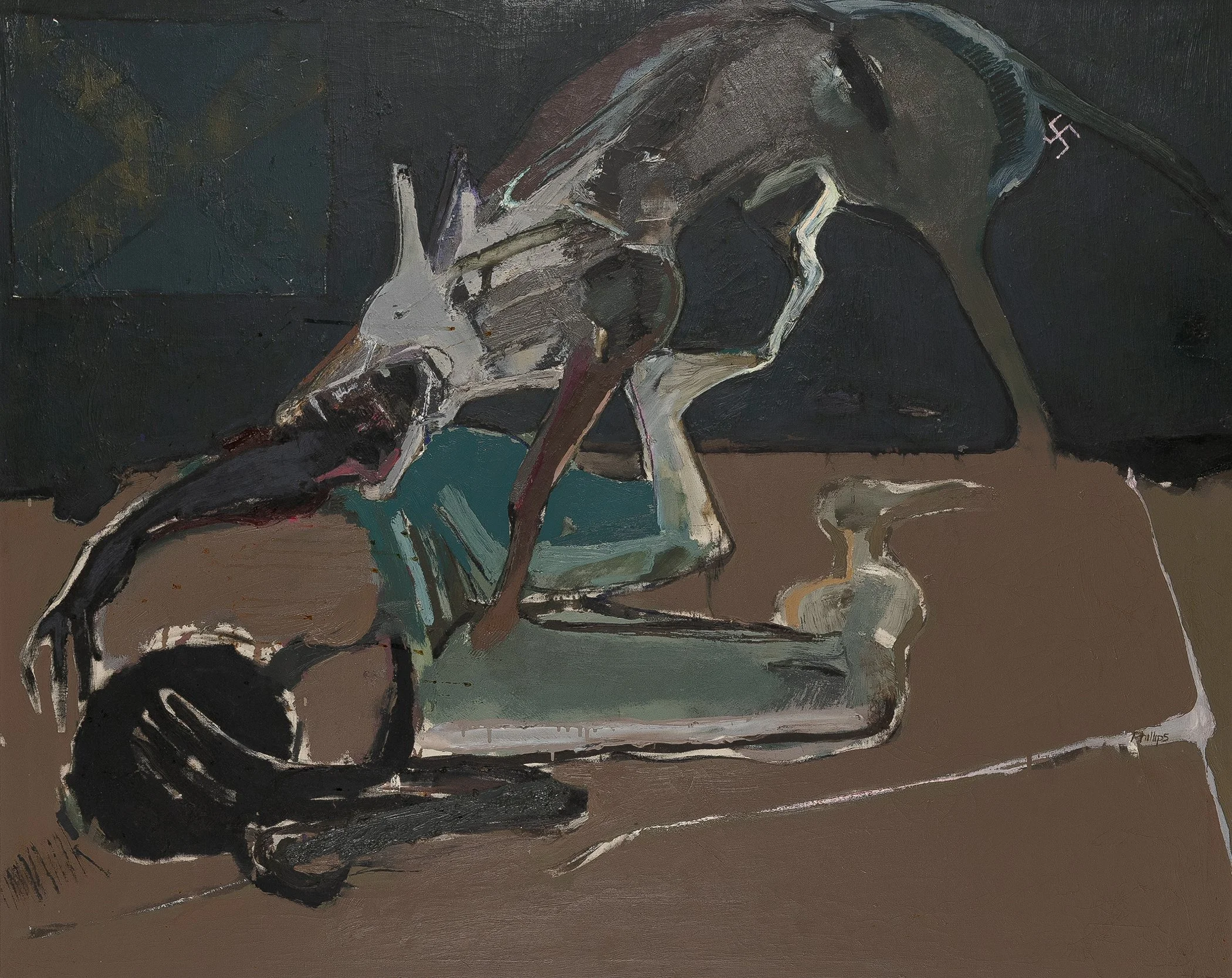
Bertrand D.
Phillips
(b. 1938)
Canine Onslaught
c. 1970
oil on canvas
41 x 51 inches
signed

“I feel the major function of my art as being an instrument in the liberation struggle of Black people, working people, and suppressed people. A recurring thought that I have been grappling with is how my art work can play a role in helping to deal a death blow to the social and political injustices that minorities in the USA are victimized by. Art done with this intent does not negate creativity, experimentation, aesthetic quality or freedom of expression as many “authorities” would have us believe.”
Selected Exhibitions
Alumni Membership Exhibition, Art Institute of Chicago, 1965
Black and White; Kovler Gallery, Chicago, IL, 1969
Solo exhibition; Elmhurst College, IL, 1970
1Black Experience; University of Chicago, IL, 1971
Solo exhibition; Elmhurst College, IL, 1971
Existence/Black; Southern Illinois University, IL, 1972
Solo exhibition; Elmhurst College, IL, 1972
Black Art Expressions; Illinois State University, Normal, IL, 1973
Directions in Afro-American Art; Herbert F. Johnson Museum of Art, Cornell University, NY, 1974
5 + 5: Ten Perspectives in Black Art; Chicago Cultural Center, IL, 1985
Changing Perceptions: The Presence of the Afro-American Visual Aesthetic in Chicago; Columbia College, Chicago, IL, 1988
Social Studies: Truth, Justice and the Afro-American Way; University Galleries, College of Fine Arts, Illinois State University, Normal
The Tenth Annual Atlanta Life National Art Competition and Exhibition; Atlanta Life Insurance Co, GA, 1990
Painter and photographer Bertrand Phillips grew up on the South Side of Chicago, where his early exposure to art began at the South Side Community Art Center. His mother enrolled him and his siblings in classes there, introducing him to a vibrant community of artists that would shape his lifelong commitment to creative expression. He went on to attend the Junior School of the Art Institute of Chicago, where he took a sculpture class with Nellie Bar, alongside classmate Richard Hunt, who would later become one of the nation’s most celebrated sculptors. Bar’s husband, Bauhaus-trained painter Paul Wieghardt, also taught at the Art Institute and became a key influence on Phillips’ development as a painter.
Though painting remained his primary focus, Phillips’ artistic vision expanded during his senior year after encountering the photography of Roy DeCarava, particularly his landmark book The Sweet Flypaper of Life. He inspired Phillips to consider photography as an additional means of artistic expression. A fellowship to study at the San Carlos Academy in Mexico further broadened his horizons, where he immersed himself in the work of the Mexican muralists, Diego Rivera, José Clemente Orozco, and David Siqueiros. Phillips was struck by how these artists, like African American artists in the United States, were underrepresented in mainstream museums.
In 1962, Phillips was drafted into the U.S. Army. When he returned, the Civil Rights Movement was reaching a fever pitch, profoundly shaping his worldview and his art. His paintings of the period, such as the one shown here, grapple with themes of violence and oppression, bearing witness to the tumultuous era. Determined to see events firsthand, Phillips traveled to New Orleans, Selma, and Mississippi. The day before his departure, Malcolm X was assassinated. On his arrival in Selma, he witnessed the first March to Montgomery led by C. T. Vivian, an event marked by the brutal attack on marchers and the murder of Jimmie Lee Jackson by an Alabama state trooper. As Phillips later recalled:
“From there I went to Selma, Alabama, and I was in Selma that Sunday of the initial March to Montgomery. This was the day the police, their marshals, and the posse gassed those marchers…when they waded in and beat heads. I was trying to do a little photography and to document as much as possible but the gas was overwhelming.”
The trauma and urgency of those experiences echoed through his art. Paintings such as the one shown above serve not only as works of expression but as historical testimony.
After years of supporting himself through factory work, Phillips eventually turned to teaching. He joined the faculty at Elmhurst College and later Northwestern University, where he taught studio art, African American art history, and established an etching studio.
While today he is best remembered for his photography, Phillips’ paintings remain vital records of the Civil Rights era, capturing the urgency, violence, and resistance that defined the time.
Ref: Fax, Elton C., and Romare Bearden. Black Artists of the New Generation. Dodd, Mead, 1977.
